Liberty Head Gold Dollars

 Liberty Gold Dollars - the smallest gold coins ever minted by the US Mint
Liberty Gold Dollars - the smallest gold coins ever minted by the US Mint
The US Mint produced the Liberty Head Gold Dollars between 1849 and 1854 at the US Mint facilities in Philadelphia, New Orleans, San Francisco, Charlotte and Dahlonega. During this short mintage period, about 12.6 million Liberty Gold Dollars were struck so these Gold Dollars are not rare gold coins. The Liberty Head Dollars are however not as easily available online as most other pre-1933 U.S. gold coins. Proofs should be even impossible to obtain since only 7 proof coins are believed to have been minted in total (all in 1849).
The Liberty Gold Dollar coins were made of 90% gold and 10% copper with each coin containing 0.04837 oz of gold. The obverse side of the coins shows a leftward facing Lady Liberty in profile. The reverse design is unique to this coin and shows a laurel wreath tied with a bow. A similar but not identical wreath design was used on the reverse of the Indian Head Gold Dollar that replaced the Liberty Gold Dollar in 1854.
When you buy gold coins that were minted in 1849, you should know that both "open wreath" and "closed wreath" varieties of the coin exist. When you study the images on this page, you will recognize the subtle differences in the reverse design of these two varieties. American buyers that are investing in gold for their retirement should take note that the $1 Liberty Gold Dollars are not eligible for inclusion in Individual Retirement Accounts (IRA's) since they are classified as collectible gold coins by the IRS.
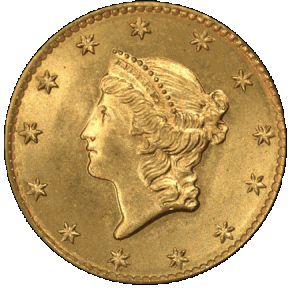
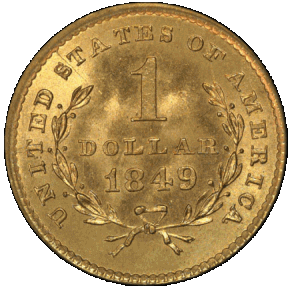
Coin Fact Sheet
| Weight | Face Value | Purity | Diameter |
|---|---|---|---|
| 0.04837 oz | US $ 1 | 90% | 13 mm |
Total Mintage: 12,565,273
Liberty Gold Dollar Coin Design
Chief Engraver James B. Longacre of the Philadelphia Mint designed the Liberty Head Gold Dollar. The obverse side depicts a leftward facing Lady Liberty in profile in the style of Greco-Roman sculptures. She wears a pearl crown that has "Liberty" inscribed on it. Thirteen stars appear along the outer edge of the coin, representing the 13 original colonies of the United States of America.
However, unlike the other coins in the Liberty Head series, the Liberty Gold Dollar coin depicts a laurel wreath tied with a bow on its reverse side. The coin's denomination and year of mintage appears in the center. Along the coin's edge is inscribed "UNITED STATES OF AMERICA".
Liberty Dollar gold coins that were minted in New Orleans (mint mark: O), San Francisco (mint mark: S), Charlotte (mint mark: C) or Dahlonega (mint mark: D) contain a mint mark just below the bow at the bottom. However, coins that were minted at the main Philadelphia branch of the United States Mint don't have any mint mark.
History of the Liberty Gold Dollar
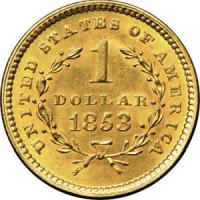
Due to the California Gold Rush in the 1840's which greatly enhanced the amount of gold circulating within the economy (including gold coins minted by private minters), the American Congress approved new denominations of gold coins to be issued under the Act of March 3rd 1849. There is some dispute whether the first Liberty Head Gold Dollars were produced on May 7th or May 8th 1849. Around 1,000 coins were minted on the first day, including a few proof coins.
In 1849, the coins were predominantly minted with open wreaths on the reverse. However, some coins minted in Charlotte and Philadelphia that year feature the closed wreath design on the reverse that appears on all the coins from 1850 on. The flipping image near the top of the page depicts an 1849 coin with an open wreath design whereas the static image to the left depicts the reverse of an 1853 coin with a closed wreath.
Production of the Liberty Head version of the Gold Dollar continued until 1854. The coins were the smallest gold coins (both in diameter - 13 mm - and in denomination) ever minted by the US Mint.
Even though production of the Liberty Dollar gold coin lasted from 1849 to 1854, only the US Mint facilities in Philadelphia and Dahlonega produced them every year during this period.
In 1854, the $1 Liberty Gold Dollar was replaced by the $1 Indian Head Gold Dollar that features an Indian princess.
Rare Dates
Both the open wreath and closed wreath issue of the Liberty Head Gold $1 Coin minted in Charlotte in 1849 is nowadays rare to find. The coins minted there between 1850 and 1853 are very rare as well.
The Liberty Gold Dollars that were minted in Dahlonega are rare for all the years of issue between 1849 and 1854.
Mintage Numbers
Annual mintage of the Liberty Head Dollar at the various US Mint branches varied between 2,935 coins (Dahlonega 1854) and 4,076,051 coins (Philadelphia 1853). Proof coins were not struck officially but at least 7 proof coins are believed to have been minted in 1849.
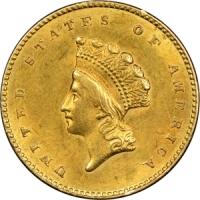
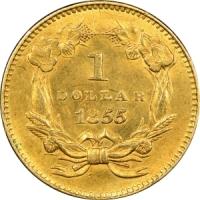
Indian Head Gold Dollars
The $1 Indian Head Gold Dollars succeeded the $1 Liberty Gold Dollars in 1854. The US Mint produced the new coins from 1854 to 1889. Two types of the coin exist that distinguish themselves by the size of the portrait on the obverse side. The coins were struck at the US Mint facilities in Philadelphia, New Orleans, San Francisco, Charlotte and Dahlonega. Their composition is 90% gold and 10% copper with each coin containing 0.04837 oz of gold. The coins' obverse shows Lady Liberty wearing a Native American headdress. Almost 7 million Indian Princess Gold Dollars were minted. An agricultural wreath of corn, cotton, wheat and tobacco that is tied with a bow can be seen on the reverse.
The Indian Gold Dollar page gives more information about the coins and allows you to compare current prices.